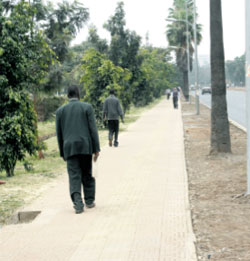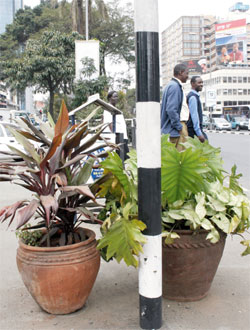By Hosea Omole
The other day, I watched with a bit of indifference as Government spokesman Dr Alfred Mutua went on about yet another ambitious effort to make Nairobi more beautiful and safe.
As he spoke, and to demonstrate just how serious the City Council of Nairobi was this time, the bushes that have for long characterised the road islands of Uhuru Highway and Mombasa Road were cleared to pave way for a brand new era of doing things.  |
Pedestrians walk on the new pavement along Uhuru Highway. |
According to the city fathers, the bushes have in the past done more harm than good by hiding criminals and serving as sanitary facilities for street families and wayward men. Indeed, insecurity in the city has, to some extent, been aggravated by poor landscape planning in public open spaces.
Insecurity, however, is perhaps just the most obvious symptom of the disease that ails our highways, streets, piazzas and parks.
And why should we believe that the people behind the initiative will actually get it right this time? What are they going to do differently?
As a way of offering solutions, I wish to look at the landscaping blunders occasioned by the city beatification programme and suggest ideas on how to return Nairobi to its former glory.
Security
This is an important component of landscape planning and design. Certain guidelines must be taken into account to ensure the resultant environment discourages crime and enhances surveillance. The physical design should, therefore, promote a sense of ownership, respect, responsibility and community. The design should also enhance natural surveillance, that is, people using the space should be able to see and be seen at all times.
Well-defined routes, spaces and entrances that provide convenient movement should be provided to facilitate easier monitoring and policing.
Appropriate use of space as well as provision of facilities that are attractive, well cared for and vandal resistant will also go a long way in preventing crime within our open spaces.
‘Dead spaces’, which are quite rampant in our city landscape today, must be eliminated. In their place, facilities that encourage people to use the space should be set up. A simple snack shop would, for instance, attract users into an otherwise dead space making it more active and safer. The more a space is actively used, the safer it gets.
Signage and Street Furniture
There is no doubt the City Council of Nairobi has made commendable steps towards providing decent street furniture for the public. However, a lot more needs to be done if we are to match standards in modern cities.
Moreover, furniture goes beyond seating and fountains. It also includes bollards, planters, statues, litterbins and even bus stop shades.
All these need to be looked at in the wider context of landscape design and never as separate entities as is the case now.  |
Potted plants are part of the Council’s city beautification programme. Photos: Omondi Onyango |
Collaboration with the private sector in the provision of these facilities is an excellent idea. However, strict guidelines need to be put in place to ensure all the elements enhance and strengthen the existing and intended future characters of their contexts.
Maintenance and Infrastructure
Generally, all landscape works must have low long-term maintenance costs. Anything more is not sustainable in the current economic environment. Therefore, plants used should be pest and disease resistant. They should also have minimum leaf fall and generally be able to last at least five years before being replaced. Trees and garden plantings should be selected and located so they don’t compromise the integrity and efficient operation of infrastructural services. Many city dwellers have complained of tree canopies that have encroached into pavements forcing users to bend over to avoid their marauding branches. Proper plant selection, location and regular maintenance is all that is needed to avoid this.
—The writer is a landscape architect.
 The Standard Group Plc is a multi-media organization with investments in media
platforms spanning newspaper print operations, television, radio broadcasting,
digital and online services. The Standard Group is recognized as a leading
multi-media house in Kenya with a key influence in matters of national and
international interest.
The Standard Group Plc is a multi-media organization with investments in media
platforms spanning newspaper print operations, television, radio broadcasting,
digital and online services. The Standard Group is recognized as a leading
multi-media house in Kenya with a key influence in matters of national and
international interest.
 The Standard Group Plc is a multi-media organization with investments in media
platforms spanning newspaper print operations, television, radio broadcasting,
digital and online services. The Standard Group is recognized as a leading
multi-media house in Kenya with a key influence in matters of national and
international interest.
The Standard Group Plc is a multi-media organization with investments in media
platforms spanning newspaper print operations, television, radio broadcasting,
digital and online services. The Standard Group is recognized as a leading
multi-media house in Kenya with a key influence in matters of national and
international interest.










